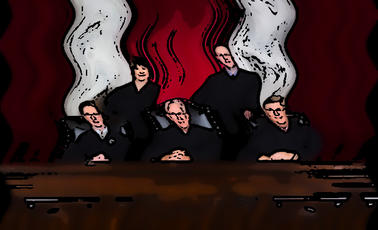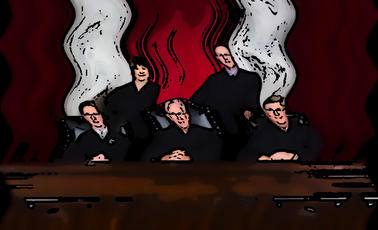By Michele Gilman | (The Conversation) | – –
Donald Trump touts that as president he would be good for American workers.
Although many of his plans are vague or possibly harmful, there is one clear outcome of a Trump presidency: with the power to appoint Supreme Court justices, Trump promises to continue a conservative majority.
We usually think of the Supreme Court in terms of what it means for abortion rights, marriage equality and the Second Amendment. At the third presidential debate, that’s what we heard.
Trump vowed to appoint justices in the mold of the late Antonin Scalia who would be hostile to Roe v. Wade and bolster gun rights. Hillary Clinton said her nominees would support women’s rights, marriage equality and reverse Citizens United.
The candidates did not, however, address the Supreme Court’s substantial impact on the workplace – an impact that’s often ignored amid these hot-button issues.
Almost five decades of a conservative Court majority have sharply limited the rights of workers to unionize, form class actions and fight discrimination. The results have been profound and help explain the deterioration of the working class and the rise of economic inequality in recent decades.
The court is now in a 4-4 split between liberal and conservative justices. The Senate’s refusal to confirm President Barack Obama’s nominee to replace Scalia means it’s likely the next occupant of the Oval Office will get to pick who fills that seat – and possibly several more. That will determine the kind of court Americans have for years or even decades to come.
Conservative appointments by a President Trump would likely continue the decimation of workplace justice, particularly collective efforts to improve working conditions and pay. As I have documented, a look back at some of the court’s recent rulings shows how.
Killing off the class action
Take the case of Wal-Mart v. Dukes.
In 2001, past and present female workers of Wal-Mart sued the company for paying and promoting them less than their male counterparts. The workers joined together to file a class action – a legal procedure that makes it possible for relatively small claims to be aggregated so that plaintiffs can afford to bring a case. They are also far more efficient for our judicial system than hearing scores of similar claims separately.
Yet in 2011, Justice Scalia wrote the opinion for a 5-4 majority that Wal-Mart was essentially too big to sue. Scalia said the plaintiff’s claims lacked a common basis and scoffed at the notion that Wal-Mart’s discretionary pay and promotion system could result in company-wide discrimination.
In dissent, Justice Ruth Ginsburg countered that discrimination is most likely to flourish in discretionary systems like Wal-mart’s due to stereotyped assumptions that managers make about female employees, even unconsciously.
As a result of the ruling, the effectiveness of the class action tool in employment cases has been reduced.
Then, in 2016, the court – without Justice Scalia – declined to expand Wal-Mart v. Dukes (in a 6-2 vote) by resisting an employer’s bid to disallow statistical evidence in all class actions.
In that case, employees at a Tyson pork processing plant used statistics to establish the amount of time they were not paid for taking on and off their protective gear. Statistical sampling was necessary because Tyson failed to keep accurate time records. The analysis showed that employees spent an average of 18 to about 21 minutes on this task, depending on their job duties. This additional time made some employees eligible for overtime pay.
As a result of the case, the use of statistics in class action cases will continue to be hotly litigated.
Eroding the right to organize
In the past, one of the key ways workers have improved their pay and working conditions is by forming a union.
Indeed, collective bargaining is associated with a wage premium of 13.6 percent, compared with workers who aren’t covered by such an agreement. Conversely, the ongoing decline in union membership is a key factor in growing economic inequality, depressing wages of union and non-union members alike.
The Supreme Court has helped accelerate that decline. In 2014, the court struck down a 2003 law granting home health care workers in Illinois who are paid by Medicaid the right to collectively bargain for better wages and working conditions.
Justice Samuel Alito concluded for the 5-4 majority that the First Amendment prohibited the state from requiring these workers to pay union dues. In so doing, he circumvented years of precedent upholding union dues for public employees as necessary to prevent free-riding by non-members and to give the state a single entity for negotiating purposes.
In dissent, Justice Elena Kagan described the labor instability that would result from the court’s ruling. She also noted evidence that collective bargaining helped the workers double their wages, obtain health insurance and receive better training and enhanced workplace safety. Those benefits could vanish without collective bargaining, harming not only the workers but also the elderly and disabled people for whom they care.
Scalia’s sudden death in February ended up giving unions a reprieve in another important case involving the constitutionality of requiring public workers to pay their fair share of union dues, even if they aren’t a member. That case, Friedrichs v. California Teachers Association, was heard in January, with a skeptical Scalia in attendance, but in March the Court issued a 4-4 decision that left a lower court’s decision upholding such fees intact.
Split decisions mean whatever ruling immediately preceded the hearing before the Supreme Court stands but doesn’t create a precedent. This issue will arise again, and, obviously, the next justice will tilt the balance.
Health care and religious belief
Health care is another area where a slim conservative majority has rolled back worker protections.
In Burwell v. Hobby Lobby Stores, Inc., Hobby Lobby and other privately held employers objected on religious grounds to paying for certain forms of legally mandated contraceptive coverage for millions of employees and their dependents. The court in 2014 upheld the employers’ religious claims in a 5-4 ruling.
In so doing, the court privileged the religious beliefs of business owners against the health care needs of employees. The decision overturned part of the Affordable Care Act – a law passed through our democratic process with an express purpose of expanding preventative care for women and reducing gender inequities in the cost of care.
The connection between access to contraception and the economic success of women is clear cut. To succeed in education and in the workplace, women need the ability to control the timing and size of their families.
The Hobby Lobby ruling expresses a robust view of equality for corporations but none for women. It might spread to other areas as well. As Justice Ginsburg asked:
“Suppose an employer’s sincerely held religious belief is offended by health coverage of vaccines, or paying the minimum wage, or according women equal pay for substantially similar work?”
The Obama Administration approved accommodations for religious employers to avoid paying for employees’ contraceptive coverage directly. All they had to do was fill out a form, and, under the accommodation, insurers would pay for it instead.
Some non-profit religious employers objected to even that and took their claim to the Supreme Court earlier this year.
Apparently at an impasse and without a ninth justice, the court sent the government and the religious employers back to the drawing board to find a solution. Thus, it remains unresolved – for now – whether the Obama Administration’s accommodation on birth control coverage is lawful. And once again, who fills Scalia’s seat will likely determine whether such coverage remains a part of Obamacare for employees of religious employers.
The Supreme Court matters
These are just a few of the more significant cases of recent years in which a slim conservative majority has rolled back worker rights.
It’s likely that these issues will continue to be fought in the courts and find their way to the Supreme Court, along with many others. Simply put, a Trump-appointed Justice is far more likely, in my view, to rule against workers than a Clinton nominee.
Whatever impact his other policies would have on the working class, it is clear his appointments for the highest court in the land would hurt workers and make it that much harder for them to join together to fight for their rights.
Michele Gilman, Venable Professor of Law, University of Baltimore
This article was originally published on The Conversation. Read the original article.




 © 2025 All Rights Reserved
© 2025 All Rights Reserved